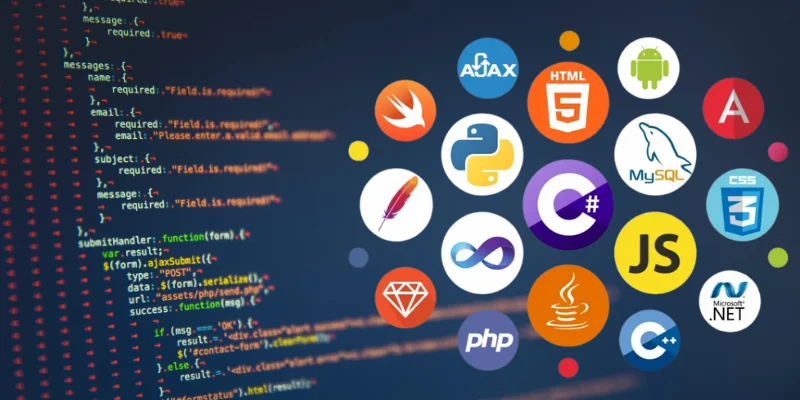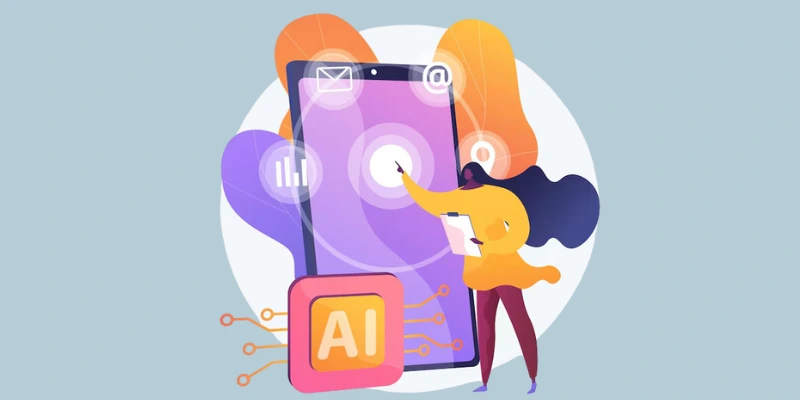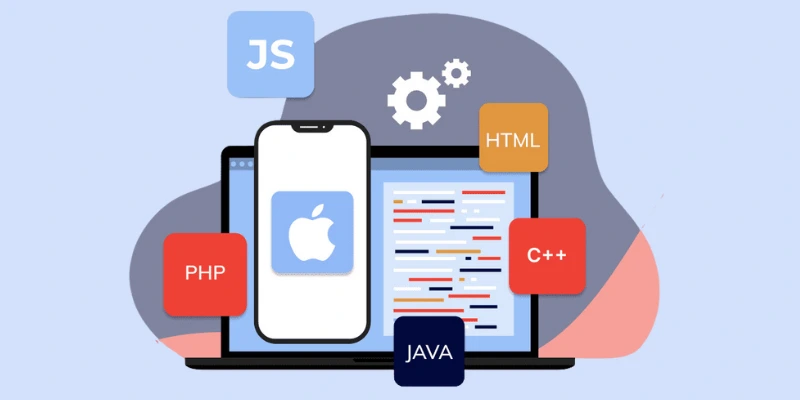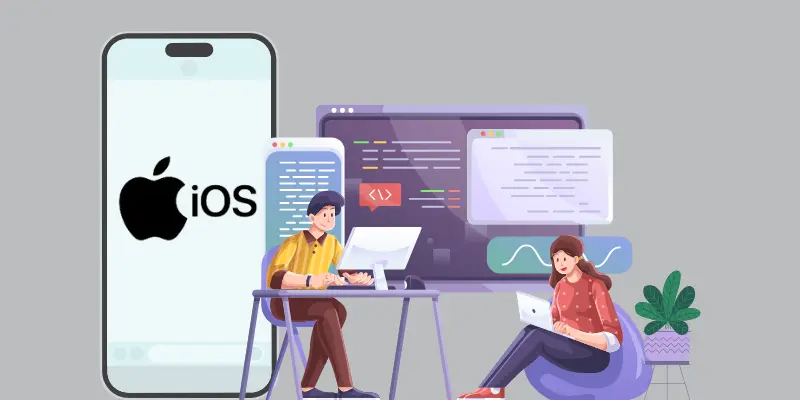Worldwide there are currently 6 billion smartphone owners today. 73% use devices running an Android OS while 27% prefer Apple technology through iOS. A common thread across both platforms is their desire for an exceptional application experience when mobile application use comes up - and we can assist 100%! In particular, this article covers iOS technology in detail while being the ultimate comprehensive guideline to guide those interested.
Consumers today desire greater opportunities for interaction with technology in any form possible, and developments in app development make this possible.
iOS application development primarily encompasses building apps designed for Apple gadgets such as the iPhone, iPad, and iPod Touch. Swift and Objective-C programming languages are utilized when developing these applications for release to customers through Apple's App Store for easy downloading. According to statistics provided by App Annie (available as of today), 69% of app downloads occur through this method annually.
As of 2021, more than 2.6 billion smartphone users and 1 billion iPhone owners exist around the globe; Apple held an estimated market value of approximately $263.4 billion at that point in time.
If your clients or business partners are among Apple's millions of users, creating an iPhone application may offer many advantages over other app development platforms. Building one is easier than you may realize!
Why Do Businesses Need A Mobile App?
As technology advances, the kind of service customers want from their businesses expands, too. In the past, firms could function without websites or email addresses. Today, apps are the centerpiece of branding and marketing. However, we should not forget that most small companies did not begin to adopt apps in the first place. Although acquisition costs were expensive, the primary reason for this was the absence of clear benefits for their business operations. It's not a question now.
Also Read: Cost-Effective Rate to Hire iOS App Developers on Remote Basis
As corporate websites offer ways to connect with customers, a new method is emerging to do similar things in a mobile space: mobile applications or software that runs on smartphones. The media craze is focused on games or location, as well as social media applications, obscuring the business benefits that Apple offers, and it could prove to be an effective tool in business development and branding that allows businesses the ability to better engage and be more connected to their intended users and then re-target them should they be missed at any time.
What is iOS Development?
In short, iOS development refers to developing apps that run on Apple's operating system. It involves creating innovative apps for iPhones, iPads, and Mac computers.
A key aspect of iOS development is the ability to master one of the two languages programming languages: Swift and Objective-C. Swift is easier to master and comprehend than Python, Java, JavaScript, C#, and C++. Swift is also a high-level programming language that is secure and has performance, as it's the most important priority, which makes it 2.6 times more efficient than Objective-C.
On the other hand, Objective-C is an all-purpose iOS programming language, a C language clone. Apple applications written in this programming language come with object-oriented features. , they create software designs based on data or objects instead of functions and logic. Most developers prefer to keep their older applications using this language instead of including them in it. Swift framework.
Why Choose iOS For Mobile App Development?
In 2024, it is expected that the iOS platform will remain the top choice for companies looking to build mobile apps increasing the demand to hire iOS developers, and it's not without reason. Here's why:

Market Reach and Revenue Potential
Android is more popular with users worldwide, while iOS has the highest number of customers who spend money on apps.
Also Read: Cost of iOS App Development
However, a recent study estimates that the App Store will reach 85.1 billion dollars by 2023. This provides an opportunity for app companies to earn income from their apps.
Premium User Experience
It is extremely difficult to evaluate the quality of all apps submitted for approval to Apple's App Store to ensure the highest quality. Apple does this.
Apple's standards for iOS apps promise an exceptional user experience that users can rely on, and ultimately, they will be loyal to more appealing and useful applications.
Strong Brand Loyalty
Apple customers are known for their devotion to the brand and spend nearly all their funds on high-quality merchandise and other services.
iOS users are well-known for their loyalty and trust in the Apple brand. Targeting this segment can help brands reap the benefits of Apple's massive recognition and credibility, reflected in their brand image.
Enhanced Security and Privacy
The processing brand iOS (Apple operating system) is well-known for its security features and rigorous privacy safeguards.
The rising concern over security breaches and privacy concerns has forced users to look at their online environment more cautiously.
To gain customers' respect, companies should consider developing applications using a platform renowned for its safety and privacy compliance.
Integration is Seamless to Apple Platforms
For companies already integrated and affixed to their Apple infrastructure, developing applications for iOS will result in coordinated manipulation that can be performed on Apple equipment and applications.
Also Read: How To Develop Your First iOS App
The seamless user experience enables companies to take advantage of Apple's useful services, like Apple Pay, Siri, and iCloud, and allows them to integrate these features into their applications.
Types of iOS App Development
iOS development can be performed for native apps, just as hybrid apps can.
Native iOS applications are designed exclusively for this platform, using iOS application development languages and tools like Swift, Objective-C, and Xcode. As opposed to other web-based apps that are built for other platforms, a native iOS application is not able to work in a browser. You can download the app via the Apple App Store.
Hybrid applications are a mix of web and native solutions. The program code is written in various programming languages, such as CSS, HTML, and JavaScript. After the code is written, it is wrapped in an app native to the platform. A hybrid app is utilized on various platforms, including iOS and Android.
Top Programming Languages for iOS Development

With all the choices available, navigating the possibilities of iOS programming languages can be quite overwhelming.
Knowing iPhone application development languages and their benefits will greatly enhance the efficiency of your iOS development process.
From Swift's performance-enhancing features and native capabilities and React Native's capability to develop cross-platform applications. Each of these languages brings an element unique to the market. Additionally, its popularity in a particular programming language can greatly impact the cost of development and the less well-known languages, resulting in more expensive costs for payroll. It's time to explore the languages deeply and learn about their distinct features.
Objective-C
Objective-C, the primary language that Apple's platforms have used for many years, is an enduring option for iOS development. Despite being deemed outdated compared to Swift, the language maintains older codebases and supports the latest iOS devices. Objective-C was developed to work with Apple's hardware, with high-end performance tailored to the needs of Apple devices.
Also Read: Important Features To Consider While Developing An iOS App
Although Swift has been gaining popularity as the primary technology to use for iOS development, Objective-C's role in the development of iOS should not be underestimated. It is a testimony to the growth of iOS programming languages and the constant advancements made within the industry.
JavaScript + React Native
The combination of mobile and web technology results in the powerful mixture of JavaScript and React Native, enabling efficient web-based development. This enables cross-platform application development, using the potential of internet technologies to build applications that seamlessly run across iOS or Android.
JavaScript, in conjunction with React Native, enables rapid development and shared codebases, making it a great option for small, short-duration iOS apps and projects. Some of the most popular apps created using React Native include:
-
-
Meta
-
Pinterest
-
Instagram
-
Uber Eats
-
These apps demonstrate the broad acceptance of the framework in the industry.
Swift
Swift is Apple's primary programming language across all its platforms, and Apple's complete help and optimization back it. It was created to provide security features such as initializing variables, checking arrays or integer overflows, and giving exclusive access to memory. Swift guarantees efficient memory use without the requirement to collect garbage.
The benefits of Swift include:
-
-
A clear syntax that doesn't need semicolons
-
Inference of type to minimize mistakes
-
Modern programming constructs include generics and tuples
-
The performance benefits are a result of LLVM's compiler technology.
-
Swift's reliability and stability are demonstrated by its widespread usage in popular apps such as Airbnb, LinkedIn, and Lyft, which also demonstrates its ability in large-scale commercial projects.
C# + Xamarin
C# and Xamarin are an extremely powerful combination for Cross-platform Android development. Utilizing Xamarin C# allows for sharing codebases on iOS and Android platforms, allowing for a unifying method of developing mobile apps. This makes for a more efficient development process for faster deployment and maintenance.
C# and Xamarin have been utilized in several notable iOS apps, such as FOX Sports and Taxfyle, as proof of their performance and versatility. This powerful cross-platform tool is an appealing solution for developers looking to make their apps available on iOS and Android platforms through an integrated, single codebase.
Dart + Flutter
Dart + Flutter, developed by Google, is a fascinating combination to create cross-platform applications using a single codebase. Flutter is a programmable UI SDK that supports the creation of highly personalized cross-platform mobile apps using Dart as the primary programming language.
Dart and Flutter are used in some of the most popular apps like:
-
-
Google Pay
-
Abbey Road Studios Topline
-
eBay Motors
-
Groupon
-
Dart's frameworks have potential in the field. They also provide benefits when developing integrated iOS apps and web applications and using Google's material design guidelines in the applications.
Things to Consider Before Choosing iOS Programming Language
Picking the correct iOS programming language requires weighing several factors: the scope of the project, its complexity, and the team's experience responsible for development. This choice shouldn't be taken lightly because the chosen language must be compatible with the app's needs and the company's goals. In addition, making sure that the app is compatible with an iOS operating system will be essential to ensure a seamless development process.
A language's flexibility can also be important. A flexible language can be used to create a wide selection of mobile apps, making it an appealing option for developers. This article will review the essential aspects to consider when choosing the iOS programming language.
Developer Expertise
The developer's knowledge is crucial in choosing the iOS programming language. The team's ability to work on development in a particular language may result in faster project completion and better code quality. So, knowing your developers' strengths and skills is essential in deciding on the right programming language.
Swift is a great start for those who want to become iOS developers. It was designed to be a language that is accessible for novices. Swift offers support through instructional tools such as Swift Playgrounds, which make the learning process more fun and easily manageable.
Project Scope and Complexity
The complexity and scope of the iOS application heavily influence the choice of programming language. Native development is typically preferred for applications that require heavy data processing or sophisticated functionality. Therefore, choosing a suitable programming language is usually based on thoroughly understanding the application's needs and desired user experience.
The factors to take into account when choosing the programming language to use to develop apps include:
-
-
The team's proficiency in the language
-
The app's future scalability will be scalable.
-
Support for community members and the language ecosystem
-
Compatibility with different versions of iOS
-
Considering these elements will allow you to connect with a large audience and offer users a seamless experience across all devices.
Cross-Platform vs. Native Development
Selecting between native and cross-platform iOS development is a key aspect influencing the choice of programming languages. Both choices have advantages and disadvantages. Highly performing and complex applications usually require in-built iOS development, whereas cross-platform development allows for faster deployment and the reach of more people with one code base.
Suitable development tools and an integrated development environment (IDE) influence the speed of productivity and software maintenance in cross-platform and native iOS development. Thus, the viability of a programming language must be evaluated in terms of its ability to accommodate many users simultaneously without compromising performance.
Basic Requirements to Develop iOS Apps
The iOS application development guide won't be complete without a few basic prerequisites. The first and most important thing is that you require a Mac computer operating macOS as Xcode is the official software development platform for iOS that can only be used through Apple's operating system. Also, you'll require an Apple Developer account to gain access to certain resources and then upload your app to the App Store.
Here's the complete list:
-
-
An Apple Developer Account is required to access developers' resources and submit new apps for approval to the App Store.
-
Although you can utilize the iOS simulator included in Xcode to test, using a physical iOS device is suggested to get a better depiction of the app's performance.
-
They are the main programming languages used for iOS development. Swift is the latest and most popular language, though older apps may utilize Objective-C.
-
Xcode comes with the iOS SDK (Software Development Kit), which offers frameworks, tools, and resources for creating iOS applications.
-
A version control software like Git will help you manage and track changes made to your code.
-
Key Trends for iOS App Development in 2024
Beyond numbers, the rise of new iOS Application Development Trends increases the influence of iOS frameworks and tools. Some such trends are creating buzz, and in the coming years, they are likely to be more prevalent, leading to significant shifts regarding the development of the iOS app procedure.
Let's review the most recent trends within iOS Development, keeping the market buzzing.
Artificial Intelligence (AI) And Machine Learning (ML)
Artificial Intelligence and Machine Learning are making waves on the scene of iOS application development for mobile devices. Developers can enhance features like personal assistants, image recognition, and personal assistants to apps that make them more effective.
What's more, an upcoming collaboration between tech giants Apple and Google is in the making. According to reports, Apple may be discussing with Google the possibility of integrating Gemini to improve the capabilities of Apple's AI.
Augmented Reality and Virtual Reality
Augmented Reality (AR) and Virtual Reality (VR) are amazing technologies revolutionizing smartphone use. AR, in particular, brings virtual items into the real world using your smartphone's camera. Remember Pokemon Go? It's a great illustration of AR in action.
Additionally, Apple has this one-of-a-kind software known as ARKit, which allows app developers to create amazing AR applications that work on iPhones or iPads. They continue to improve their tool, and now the most recent version, ARKit-6, has become more effective. It lets AR feel like it's an actual part of the world. This means you can use it to test furniture before buying it or gain knowledge about historical sites by seeing virtual information overlayed over them.
Apple Pay
Apple Pay is a simple payment option on your iPhone and any other Apple device. It lets you easily buy things in stores or online and transfer money to your loved ones. Users love using Apple Pay because it's safe and secure, securing the information they use to pay for purchases from loss. In addition, you do not have to swipe your cards every time you make a transaction, which makes transactions smoother.
You can put away your physical credit cards at home and pay for things regardless of where you are. This is why more people are turning to Apple Pay, which is becoming more popular with different applications!
Swift Package Manager
Swift Package Manager is like a centralized hub where developers can access and utilize code libraries. This simplifies ensuring consistency and avoids repeatedly writing the same code.
Using Swift Package Manager, developers can easily locate, add, or update the code libraries they require to build their projects. They can also design custom code libraries and distribute them to other developers. This allows teams to collaborate on projects and speeds up the introduction of new features or the fixing of problems.
Blockchain Technology
Blockchain technology began with cryptocurrency and is expected to become the next big thing in iOS development by 2024. The technology will be integrated into iPhones and tablets to ensure that apps are secure and reliable. This means your information will be protected, and you can depend more on the apps you run on the Apple device.
Steps to Develop an iOS Application in 2024

Creating an iOS application from scratch demands an exhaustive process and the need to hire iOS developers that will ensure its success in the highly competitive app market. Whether you're an experienced developer or new to the field, adhering to the right steps can simplify your efforts and improve your chances of creating an appealing product.
Here are six crucial steps that will guide you through creating an iOS app starting from scratch in 2024.
Idea and Planning
Start by imagining your app's concept and then determining its purpose, target audience, and most important characteristics. Conduct market research to identify users' preferences and needs. Develop a detailed plan that outlines the app's functions, design, and user experience.
Design
Create wireframes and mock-ups of your app's UI using design tools such as Sketch, Adobe XD, or Figma. Create the visual elements, including buttons, icons, and color schemes, adhering to Apple's Human Interface Guidelines for iOS apps.
Development Environment Setup
Install Xcode, Apple's integrated environment (IDE), on your Mac to assist with iOS app development. Xcode has everything you require to build iOS applications, including the code editor, debugger, and interface builder.
Coding
Create the program code using Swift or Objective-C, the main programming language for iOS development. Implement the features and functionality outlined in your app's design, following best practices and design patterns like Model-View-Controller (MVC) or SwiftUI.
Testing
Examine your app in depth to discover and correct any issues or bugs. Use Xcode's built-in tools for testing and debugging on real or simulator iOS devices. Consider the possibility of beta testing with a small number of users to collect feedback and improve.
Deployment
Establish App IDs and provision profiles and distribution certificates on Apple's Developer Portal to ensure your app is ready for deployment into your App Store. Then, create a package for your app and your own App Store listing, including pictures and descriptions, and submit it to be reviewed by the Apple App Store staff.
Hidden Costs to Consider in iOS App Development
In planning your iOS application development, it's important to be aware of not only the obvious costs but also not to overlook hidden costs that may be hidden from your view. Beyond the initial costs for iOS development, a few lesser-known aspects could significantly affect your budget.
Here's a list of some hidden expenses that you ought to be aware of
Data Storage Cost
The cost of storing data in the app is high. When dealing with user-generated media files, content, or other types of data, ensuring you've enough storage space could be costly. On average, you'll need to spend approximately $500 annually on data storage.
Content Delivery Network (CDN)
Using a CDN's services to ensure efficient content delivery is crucial, particularly for applications with a global audience or that handle large media files. CDN services guarantee speedy and reliable content delivery, but they also come at costs. Spend around $200 annually on CDN solutions to ensure maximum performance for your application.
Account Cost of the App Developer
To make your iOS app available on the App Store, you must join the Apple Developer Program, which costs $100 annually. This cost is often overlooked but crucial to access all the resources and tools required for app development and distribution.
Annual iOS Updates
Apple frequently releases updates to its iOS operating system that introduce updates, new functions, bug fixes, and security improvements. Ensuring your app is up-to-date with the most recent iOS versions demands ongoing maintenance and updates. These may result in expenses. You should budget about 11,000 annually to adapt your app to the latest iOS updates.
Monitoring and Maintenance
After your app has been launched, it's not over. Examining performance problems, responding to users' feedback, and maintaining up-to-date knowledge of the latest technology are ongoing chores. Based on the nature of your application and the support you require for monitoring and maintenance, the costs can vary from $3,000 to $12,000 annually.
The Key Takeaway
How we view the functionality and features we use is changing, and so is the development process. Thanks to modern development techniques, we can now offer MVPs to consider. Careful planning and analysis before starting development, and possibly using wireframes, could simplify the first steps.
As a pioneering iOS app development company, JPLoft co-innovates with you and takes an innovative approach to outcomes-driven development services. With decades of experience offering iOS app development services, our team of experts focuses on delivering results by balancing mobile app development consultancy and strategy, technical capabilities, efficiency, and cost.
Additionally, if you encounter difficulties or hurdles in developing an iOS app, JPLoft always has your support. Our experts will help you build your first iOS application from scratch. Contact us for help in your time of need.














Share this blog